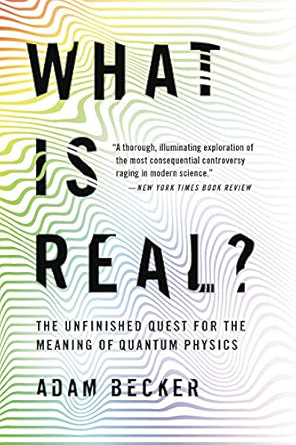More on this book
Community
Kindle Notes & Highlights
by
Adam Becker
Started reading
October 11, 2024
won him a Nobe...
This highlight has been truncated due to consecutive passage length restrictions.
increasingly complex results in high-energy particle physics that were pouring in from the growing number of particle accelerators around the world. And nonrelativistic quantum theory was also being used to great success in other areas, such as solid-state physics.
nobody could see how to apply his new ideas about quantum theory to the wide variety of interesting problems at hand.
Bohm’s theory would have to account for the successes of QFT and connect to other areas of
already active research if it were to survive.
Bohm’s geographical and ideological isolation was taking a serious toll on his scientific work.
Most disappointing of all, though, was Einstein’s reaction to Bohm’s work.
theory would have to be strange to reproduce the counterintuitive results of quantum physics.
Einstein couldn’t see any physical reason to give up locality—
Einstein wanted a new way of looking at nature,
Einstein hoped to find such a picture in a unified field theory,
Einstein was still generally supportive of Bohm.
Bohm became a Brazilian citizen on December 20, 1954. Several months later, Bohm finally left Brazil, after nearly four years there.
Together, they found a surprising new consequence of quantum physics that would be Bohm’s best-known work in “normal” physics: the Aharonov-Bohm effect, an unusual feature of the behavior of electrons and other charged particles traveling near electromagnetic fields.
After writing his book on the subject, Bohm decided that he had been mistaken and that his interpretation didn’t work after all—though he still didn’t think the orthodox Copenhagen view could be right either.
the wake of the brutal suppression of the Hungarian Uprising in 1956, Bohm abandoned his Marxism.
Several years later, he found a permanent position at Birkbeck College at the University of London.
offered two permanent positions in the United States:
Brandeis Uni...
This highlight has been truncated due to consecutive passage length restrictions.
Institute of Mining and T...
This highlight has been truncated due to consecutive passage length restrictions.
He could return and become
renounced communism.
Unwilling to compromise his integrity, Bohm remained at Birkbeck.
pilot-wave interpretation sank into obscurity
But back at Princeton, where all his troubles began, a new alternative h...
This highlight has been truncated due to consecutive passage length restrictions.
Albert Einstein gave the last lecture of his life in Princeton, New Jersey, on April 14, 1954.
the subject inevitably turned to the role of the observer in quantum physics.
“When a mouse observes, does that change the state of the universe?”
Hugh Everett, was putting Einstein’s words to good use in defense of his own new interpretation of quantum physics.
But, unlike Bohm, Everett’s solution didn’t involve pilot waves. Everett’s answer to the questions that lurked at the foundations of quantum physics was wholly original—and far stranger than anything Bohm or Einstein had ever proposed.
Einstein replied, saying that while unstoppable
forces and immovable objects weren’t real,
impressing his professors and classmates with his remarkable facility for math and logic.
taste for paradoxes was still lively.
And for Everett, fun entailed gaming out the logical consequences of a statement and winning the argument at hand.
Everett had scored in the 99th percentile on the brand-new physics GRE, and he had stellar letters of recommendation:
National Science Foundation (NSF), also brand new, was similarly impressed, and paid for Everett’s graduate tuition and stipend.
favorite sport was one-upmanship,”
He was smart in a very broad way.
mathematical theory of games.
weekly game theory seminar
visiting luminaries, including John Nash.
ultimately wrote and presented a short paper there that went on to be a...
This highlight has been truncated due to consecutive passage length restrictions.
increasingly captured by quantum physics.
Everett saw there was a problem lurking at the heart of the theory.
Everett didn’t particularly care about what was or wasn’t reputable.
experts on the foundations of quantum physics in Princeton at the time, like Wigner and von Neumann, didn’t always see eye to eye with Bohr.
John Wheeler, was obsessed with his own disreputable problem, general relativity.
trying to solve: marrying general relativity to quantum physics in a single theory of quantum gravity,
enlisted Charlie Misner,


